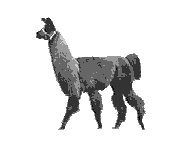|














| |
-
 Why llamas? It started with a desire to
relieve ourselves of the burden of packing our own gear on backpacking
trips. Horses and mules were just too high maintenance and costly for all the paraphernalia
that goes with them. After a bit of research as to the alternatives,
llamas were the natural choice! Why llamas? It started with a desire to
relieve ourselves of the burden of packing our own gear on backpacking
trips. Horses and mules were just too high maintenance and costly for all the paraphernalia
that goes with them. After a bit of research as to the alternatives,
llamas were the natural choice!
- Llamas are relatively easy to train to lead, load and carry a pack, and
are even trained to pull carts. The ultimate packing companion, llamas
have low impact on the environment -- permitted in places horses, donkeys and
mules are not. This is mostly due to the padded feet instead of hooves, they don't
poop along the trail, and their "llama beans" (which look similar to deer pellets)
do not contain viable weed seeds. Also, being they don't eat much, it's
usually unnecessary to carry in any hay, which can also carry weed seeds.
- Transportation is much easier than with horses and cattle -- vans, trucks, trailers and even station wagons are used. They usually kush (lie down) in transit.
- Llamas are easy to raise and are low maintenance. They are very clean &
intelligent -- making excellent pets and companions. Each llama has it's own personality and soon becomes more like a member of the family than just a pet.
- Llamas require little space; 1/8 of an acre is adequate for a llama and a 4 foot field fence is usually
fine. But as with dogs, more space to run around and some varied terrain makes
for a happier llama. Being a herd animal they need company.
- Llamas only eat between 4-6 lbs. of pasture grass (not alfalfa) hay per
day and require no special diet. In pasture they browse and have a very
efficient digestive system. A varied pasture (little need to worry about
broadleaf weeds) provides all they need, with
some mineral supplementation depending on soil conditions.
- Llamas establish communal "potty" piles which are practically odorless. Their pellets,
sometimes referred to as "llama beans", make a very good, weed-free fertilizer.
- Gentle and inquisitive, llamas are quiet, peaceful, dignified animals and
typically communicate with soothing humming sounds.
- Llamas get along well with other animals, including friendly family dogs, once they
establish the animal is no threat. Being quite discriminating, this
relationship is quickly learned on an individual basis (and not forgotten).
- A llama, or more typically two, can be an efficient and effective "guard" for sheep,
goats, fowl, or young cattle. They are renown for their ability to
spot and drive away coyotes and other predators -- confronting and physically attacking them
if necessary -- and working in unison. The teamwork is quite amazing
to behold. Spotting a potential threat will first elicit a warning
call to alert others.
- Research by Kelly Powell, who interviewed 145 sheep producers who used
llamas as sheep guards, revealed that over 50% of the guard llamas completely
eliminated predator losses. Another 40 to 45% reduced losses to less
than 10% of unguarded rates. The size of land covered didn't appear to
affect effectiveness, as the llamas tend to keep the sheep herded together and
close by (under watch).
- Llama adults generally weigh 275 to 450 lbs. They can live 20 to 25 years
-- about the same as a horse.
- Llamas can be first bred at 18 to 24 months, but such young pregnancies are not
healthy. Three years is preferable. Their gestation period is
about 350 days (longer in Spring, shorter in Autumn). Llamas are full grown
at 4 years of age.
- Llamas are classified as livestock.
- They're just so cute!

Mighty-fine Gold
  In
addition, their hollow-core wool provides a fine, naturally water proof, light
weight, insulated fiber for spinning.
Gayle has taken up this art as a hobby. In
addition, their hollow-core wool provides a fine, naturally water proof, light
weight, insulated fiber for spinning.
Gayle has taken up this art as a hobby.
|

